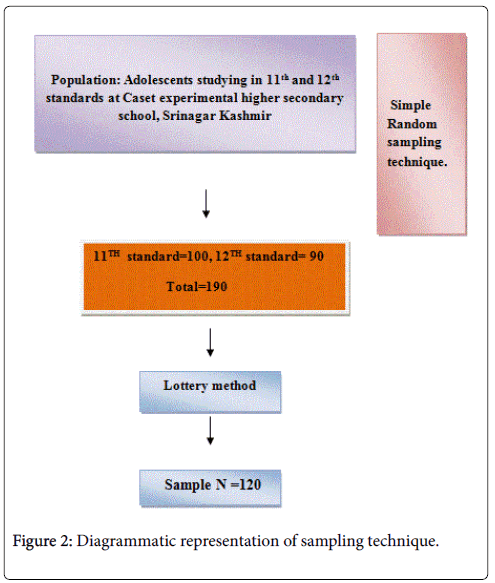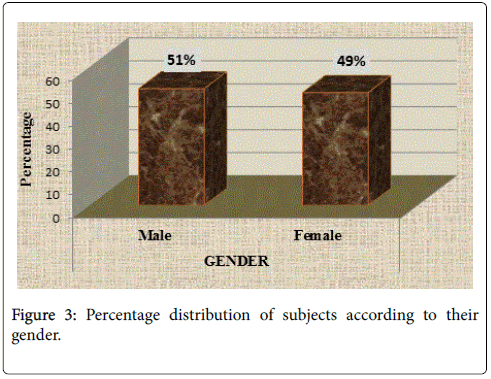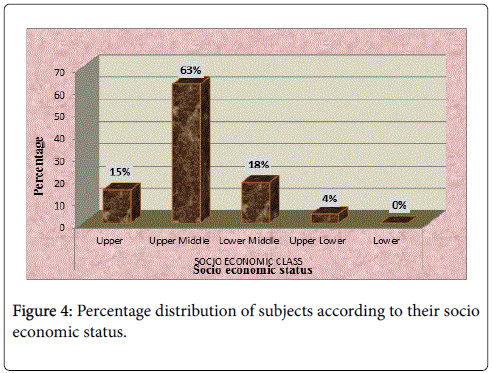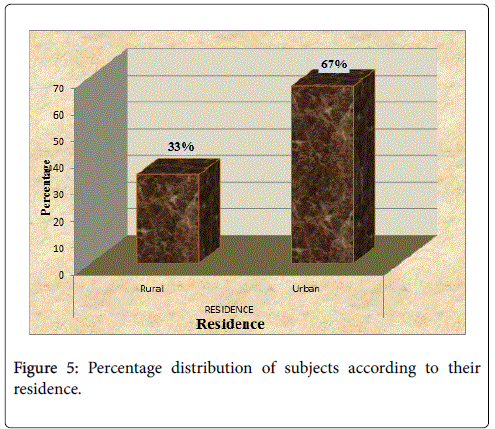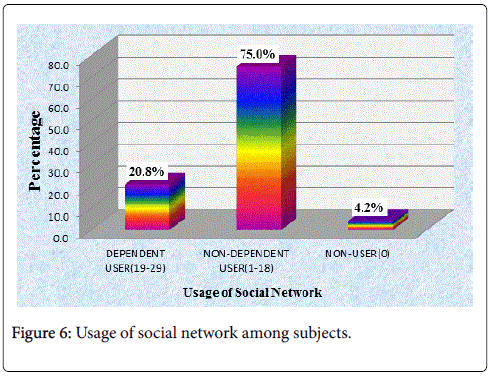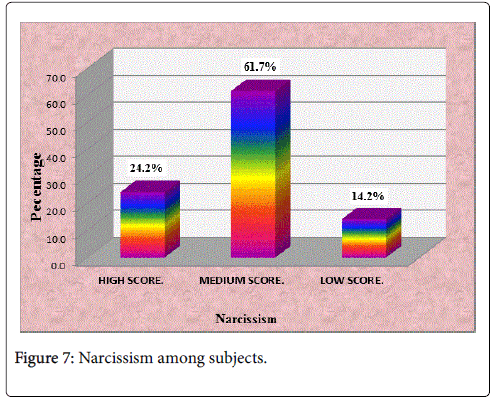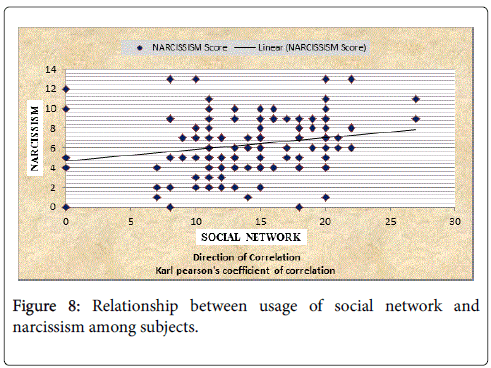Inventory for Social Network Addiction
Received: 05-Nov-2018 / Accepted Date: 22-Nov-2018 / Published Date: 29-Nov-2018 DOI: 10.4172/2155-6105.1000371
Abstract
This study aims to identify the prevalence and factors associated with usage and dependence of social network among adolescents and to develop and validate an inventory to measure social network usage and addiction. Social networking sites offer users near complete control over self-presentations, making these sites a useful venue for the deployment of strategic interpersonal behavior that the users use to construct and maintain carefully considered selfimage.
Methodology: Quantitative descriptive design was used to identify the usage and dependence of social network among adolescents, to identify the Narcissism among adolescents using social network, to determine the association of usage of social network among the adolescents with their selected demographic variables (Gender, Socio-Economic Status and Residence) and to assess the relationship between social network usage and Narcissism among the adolescents, since the quantitative descriptive design aided in attaining first-hand information and enhanced obtaining accurate and meaningful information data. Simple random sampling technique was used to collect data from adolescents who fulfilled the inclusion criteria. Data was collected using self-structured inventory for social network usage and narcissistic personality inventory. The tool was validated by 9 experts. Reliability of the tool was established by using karlpearson’s correlation coefficient (“r”=0.94). Pilot study was conducted on 12 adolescents studying in 11th and 12th standards at Caset Experimental Higher Secondary School, Srinagar, Kashmir. The main study was conducted on 120 adolescents studying in 11th and 12th standards at Caset Experimental Higher Secondary School, Srinagar and Kashmir from 17/08/2017 to 17/09/2017. Ethical clearance was obtained and study was found ethically exempted. Data was analyzed using descriptive and inferential statistics.
Results: The result of the study revealed that that maximum number of subjects 75.0% were non-dependent users, 20.8% subjects were dependent users and 4.2% subjects were non users. Also, maximum number of subjects 61.7% had medium Narcissism, 24.2% subjects had high Narcissism and 14.2% had low Narcissism.
The findings of the present study showed that there was significant correlation between usage of social network and Narcissism scores (r=0.207, P=0.023). The findings of the study concluded that there was relationship between usage of social network and Narcissism implying that social network usage increases the Narcissism.
Further, there was no significant association of usage of social network with gender and socio economic status whereas as significant association was found with residence. Also, no significant association was found between Narcissism and selected demographic variables such as gender, socio economic status and residence.
Conclusion: The findings of the study concluded that majority of the subjects were non-dependent social network users with medium Narcissism. Also, there was significant correlation between usage of social network and Narcissism scores implying that increased social network usage increases the Narcissism.
Implication: Identifying the relationship between social network usage and Narcissism will help to enhance knowledge among adolescents regarding ill effects from excessive use of social networking.
Keywords: Social network inventory; Social network usage; Social network addiction; Narcissism; Adolescents; Relationship
Introduction
This is the age of information, where knowledge is power. The digital revolution has provided mankind with the ability to treat information with mathematical precision, to transmit it with high accuracy and to manipulate it. The internet makes it possible to access and share information globally. The name internet stands for International Network of Computers. It is highly enlightening and entertaining media; therefore almost all people in the world got addicted to it in one way or the other and engaged themselves with one activity or the other on it. One such activity is the use of social networking sites and social media [1].
The introduction of social network in the last decade has largely attracted many people. This has therefore shifted their focus from mainly using just traditional media and traditional forms of social networking for social interaction .The mass appeal of social media could be an issue of concern, especially with regards to the steady increase in the time users spend online. Also, the qualities of social media make it a desirable escape for many of these people increasing their dependency on it; thereby contributing to the growth of the social media addiction phenomenon worldwide [2].
The beginning of the modern social media and social networking phenomenon can be traced back to 1997 with a site called Six Degrees. As the first site of its kind, it allowed users to create a profile as well as an online network of friends and other acquaintances. Since 1997 many more social media and social networking sites have emerged and are constantly evolving and competing to include new features and functions [3].
According to Lenhart, the most commonly used social media sites are Facebook (41%), Instagram (20%), Snapchat (11%), Twitter (6%), Google+ (5%), Tumblr (3%), Vine (1%) and other social media sites (1%). With the adaptive and evolving nature of modern technology, social media and social networking sites are constantly being updated and changed. In addition there is a steady creation of new sites. From the beginning of 2006 to the end of 2008, a site called MySpace went from the most popular social networking site to being eclipsed by its newly emerging competitor Facebook. The constant popularity shifts between sites may act as a challenge for researchers when comparing effects of social site usage from year to year or even month to month. Lenhart also found that 71% of teens reported using more than one form of social site, which may also pose a challenge when comparing adolescents’ social media and social networking site usage. It is important to address the terms “social media” and “social network” and the context they are using within this paper. Originally the difference between the two could be distinguished based on their features and functions. However, as all of these sites are updated, there is an increasing amount of overlap in the features that social media versus social networking sites offer. Originally social media sites focused on providing an outlet for broadcasting whereas social networks were used as a way of communication and connecting with others. Now, with such a large overlap in features, both types of sites allow users to communicate and share information as well as videos and photographs to a controlled group of viewers or followers. Users are given the option to “friend” or “follow” each other giving them access to each other’s posts. These sites feature the option for users to show approval through sharing, commenting or “liking” posts. Some sites focus on two-way communication as a way of creating and maintaining connections and networks by providing features such as direct messaging, instant messaging and the ability to tag specific people in posts or comments [4].
Social networking has taken over the online communication sphere. Researchers are well aware how new technology influences the daily lives of children and adolescents. The social networking phenomenon, in particular, has sparked excitement and concern in recent years, not only from a general entertainment perspective, but also from a business, public relations, marketing and advertising perspective as well. The social media addiction field is widely emerging and relatively there is unavailability of measuring instruments, with the first studies appearing after 2010 Ryan et al. [5]. Furthermore, while there are several validated instruments for measuring game addiction e.g. Griffiths [6], Lemmens et al. [7]; Lemmens et al. [8]; no validated instruments exist measuring social media addiction. Instead, the field of social media addiction is characterized by an abundance of measurement instruments tapping into particular forms of compulsive social media use, such as Facebook addiction Ryan et al., [5] and addiction to social network sites Griffiths et al. [9].
Literature Review
Prevalence of social network usage
Murat et al. [10] conducted a study on 271 students between the ages of 14-18 yrs to determine the level of social media addiction among young people in Turkey. Findings showed that low addiction level among 14 yrs age group increases with age up to 17 yrs and the level decreases in 18 yrs age group.
Adoasi [11] conducted a study to assess the level of social media addiction among 200 students of the University of Ghana. Data was collected by using self-administered questionnaires which was made up of 13 items from the Internet Addiction Test (IAT). Findings revealed that 19% of the respondents were not within the social media addiction bracket, 1% of the respondents were severely addicted and 80% of the respondents were mildly addicted to social media.
Dau [12] conducted a study to investigate various social media sites used by students and the frequency at which they use them using the survey method. Five (5) tertiary institutions in Katsina state were selected out of which 800 students were sampled. Findings of the study showed that majority of the respondents use almost all popular social media platforms with Facebook having the largest number of users. He also found that majority of the respondents use these social media platforms mainly for social needs such as friendship and dating.
Ching et al. [13] conducted a study on 228 participants between August 2014 and September 2014 to complete a set of questionnaires, including the SAS and the modified Kimberly Young Internet addiction test (IAT) in the Malay language. Findings showed that there were 99 males and 129 females with ages ranging from 19 to 22 yrs old (21.7 ± 1.1) included in this study. Descriptive and factor analyses, intra-class coefficients, t-tests and correlation analyses were conducted to verify the reliability and validity of the SAS. Bartlett’s test of sphericity was significant (p<0.01) and the Kaiser-Mayer-Olkin measure of sampling adequacy for the SAS-M was 0.92, indicating meritoriously that the factor analysis was appropriate. The internal consistency and concurrent validity of the SAS-M were verified (Cronbach’s alpha=0.94). All of the subscales of the SAS-M, except for positive anticipation, were significantly related to the Malay version of the IAT.
Ching et al. [14] conducted study among 426 medical students. The study population consisted of 156 males (36.6%) and 270 females (63.4%). Findings showed that the mean age was 21.6 ± 1.5 yrs. Ethnicity distribution among the students was: Malays (55.6%), Chinese (34.7%), Indians (7.3%) and others (2.3%). According to the IAT, 36.9% of the study sample was addicted to the internet. Using the multivariate logistic regression analysis, we have found that the use of internet access for entertainment purposes (Odds Ratio [OR] 3.5, 95% confidence interval [CI] 1.05-12.00), male students (OR 1.8, 95% CI 1.01-3.21) and increasing frequency of internet usage were associated with internet addiction (OR 1.4, 95% CI 1.09-1.67).
Poellhuber and Anderson [15] conducted a study to describe the use and interest in social media. A 90-item online questionnaire was completed by 3,462 students between July, 2009 and February, 2010. The demographic characteristics constitute a large percentage of females (75.3%) and students of varying ages categorized by five 8 yrs spans: Generation Z, 16-24 (37.2%); Generation Y, 25-32 (27.2%); Generation X2, 33-40 (16.1%); Generation X1, 41-48 (10.5%); and Baby Boomers, 49 and over (5.3%). In terms of user proficiency, the results revealed that a significant percentage of study respondents reported being either advanced or expert users of Social Networking (69.5%), video sharing (52.9%), photo sharing (33.7%) and blogging (25.4%) tools. Quite the reverse was reported for social bookmarking, virtual worlds, electronic portfolios, tweeting, Web conferencing, podcasting and wikis, as respondents self-professed lower levels of proficiency with such tools. In terms of interest in using social media for academic practice, the study respondents demonstrated a higher interest in using those social media tools for which they were most familiar. Ranked by the percentage of interested respondents, the list includes the following: video sharing (58.2%), Social Networking (52.8%), Web conferencing (42.6%), blogging (40.2%), photo sharing (36.4%), podcasting (33.7%), wikis (31.3%), electronic portfolios (28.5%), virtual worlds (19.4%), tweeting (18.5%) and social bookmarking (18.1%).
Lenhart et al. [16] conducted a cohort study on 2253 adults (18 and older) to assess the use of social media in the United States. The findings revealed that 72% of survey respondents use social networking sites with an increase in the number of profiles maintained on multiple sites compared to the prior year. Among profile owners, Facebook was currently the social network of choice (73%), whereas only 48% and 14% maintain profiles on MySpace and LinkedIn, respectively. Additionally, 19% of the survey respondents use Twitter while only 4% use virtual worlds such as Second Life. A number of survey respondents reported participating in content creation activities with 30% “sharing” self-created content such as photos, videos and artwork; 15% “remixing” material such as songs or images to showcase their artistic abilities; and 11% “blogging” to inform, update, or notify readers about specific topics and/or events.
Liu [17] conducted a study to identify the knowledge and trends of using 16 social media tools that included Facebook, Wiki, YouTube, Bulleting Board, LinkedIn, Blogs, Twitter, Podcasts, Virtual Worlds, RSS, Stumble Upon, Netlog, Delicious, Digg, Plurk and Jaiku among students. Through an online survey, 221 students were asked to rate their knowledge level of each social media tool using a Likert scale of 1-4 (1=not at all knowledgeable, 2=somewhat knowledgeable, 3=knowledgeable and 4=very knowledgeable). The results revealed the following: (a) 82%, 77% and 70% were either “very knowledgeable” or “knowledgeable” about YouTube, Wiki and Facebook, respectively; (b) 42%, 41% and 39% were “somewhat knowledgeable” about podcasts, blogs and forums, respectively; and (c) 42%, 40% and 25% were “not at all knowledgeable” about virtual worlds, RSS and Twitter, respectively.
Factors associated with social network usage
Casale et al. [18] conducted a study with a sample of 535 students completed the 16-item Narcissistic Personality Inventory, the Hypersensitive Narcissism Scale and the Generalized Problematic Internet Use Scale-2 (GPIUS2). Vulnerable narcissists reported: (a) significant higher levels on all GPIUS2 subscales and total scores than non-narcissists and (b) a stronger preference for online social interactions and higher overall levels of problematic use of SNSs than grandiose narcissists. Conversely, no significant differences were found between grandiose narcissists and non-narcissists. This study suggests that vulnerable narcissism may contribute more to problematic use of SNSs than grandiose narcissism.
Pantic et al. [19] on a sample of 244 students, researcher investigated social networking activities, such as number of self-portrait photographs ("selfies") and their potential connection with self-esteem and narcissism. Each participant completed a questionnaire consisting of Young Internet Addiction Test, Rosenberg Self-Esteem scale and Narcissistic Personality Inventory. There was a statistically significant negative correlation between internet addiction score and self-esteem. Internet addiction increased as self-esteem decreased and vice versa. On the other hand, there was a positive correlation between internet addiction and narcissism. NPI score and number of self-portrait photographs (selfies) on Facebook were also in a positive relationship. Conversely, NPI score increased as the self-esteem decreased. The results of the study are in accordance with our previous findings on Internet use and mental health, confirming that Internet addiction is a potentially a serious public health problem.
Andreassen, et al. [20] conducted a study to examine the associations between addictive use of social media, Narcissism and self-esteem. A cross sectional convenient sample of 23,532 Norwegians completed an open web based survey with Bergen Social Media Addiction Scale (BSMAS), NPI-16 and the Rosenberg Self Esteem Scale. Findings revealed that lower age, being a woman, being a student, lower education; lower self-esteem and Narcissism were associated with higher scores on the BSMAS.
Jessica [21] conducted a meta analytic review to find the relationships between grandiose and vulnerable Narcissism and (a) time spent on social media, (b) frequency of status updates/tweets on social media, (c) number of friends/followers on social media and (d) frequency of posting pictures of self or selfies on social media. Findings revealed that grandiose Narcissism is positively related to all four indices, although culture and social media platform significantly moderated the results. Also Vulnerable Narcissism was not significantly related to social media use.
Paramboukis et al. [22] conducted a study to examine the relationship between Narcissism, self-esteem and Instagram usage A sample of 200 participants responded to an online survey which consisted of the Five Factor Narcissism Inventory (FFNI), the Rosenberg Self-Esteem scale and the Instagram Usage, Behaviours and Affective Responses Questionnaire (IUBARQ) constructed specifically for the purposes of this study. Findings revealed that overall Narcissism (FFNI Total) did not correlate with self-esteem (RSS). However when Narcissism was separated into grandiose and vulnerable dimensions, a weak positive correlation was found between grandiose Narcissism and self-esteem (ρ=0.35, p<0.001), whilst a negative moderate strength correlation was found between vulnerable Narcissism and self-esteem (ρ=−0.59, p<0.001). That is, those Instagram users with higher levels of grandiose Narcissism tended to report higher self-esteem levels, whilst vulnerable narcissists reported lower self-esteem levels. All three Narcissism scores were positively associated with both Instagram Attitudes and Instagram Behaviors, but the relationships between selfesteem and both Instagram Attitudes and Instagram Behaviors were not significant.
Development of Tool
The development of Inventory for Social Network Addiction was primarily based on Clinical presentations of addiction. Typical components of what is described as “addiction” are the following:
• Salience/Excessive use-often associated with a loss of or diminished control over the activity and impaired time management.
• Withdrawal-including feelings of anger, tension, anxiety and/or depression, when the Internet/computers are inaccessible
• Tolerance-including the need for more hours of use
• Negative repercussions/Conflict-including self-imposed social isolation and disintegration, lying, arguing, poor academic and occupational achievement and fatigue
• Craving-including urge and obsessions related to an online activity
• Mood modification-including the use of online activity to cope with negative emotional states or boredom.
In other words, individuals addicted to the Internet focus excessive numbers of hours on internet-related activities at the expense of broader life activities, including those associated with fulfilling the basic needs (e.g., food, sleep, intimate contacts) [23].
The current study
This study aims to identify the prevalence and factors associated with usage and dependence of social network among adolescents and to develop and validate an inventory to measure social network usage and addiction.
Description of items
Inventory has been formulated in two parts “Part I and Part II” with 7 items in Part I and 6 items in Part II respectively, with total of 13 items. Respondent has to read each description in Part I and place a “Tick” on either of statements of pair, respondent may feel that neither of statement describes his/her action well, but should pick the one that comes closest. While in part II Respondent has to read each description and place a “Tick” on every statement (one or more in an item) that is closest to describing his/her behavior, feelings and beliefs about Social Network. All Items should be completed.
The items in the inventory determine the features of addiction mentioned above. Some items are specific to one feature while some items are related to more than one feature.
• Item number 1 describe whether the respondents use social network/networks, if not, all other items will become insignificant.
• Item number 2 and 3 determine the features of Salience/Excessive use.
• Item number 4 and 5 determine the features of Tolerance.
• Item number 6 and 7 determine the features of Withdrawal.
• Item number 10 and 12 and determine the features of Negative repercussion.
• Item number 8 and 9 determine the features of Craving.
• Item number 11 and 13 determine the features of Mood modification.
Scoring of inventory for social network addiction
• Highest score=29
• Lowest Score=Non-Users score=0 mark.
• Non-Dependent users score less than 1-18 marks.
• Dependent Users=addicted users score 19-29 marks.
Item scoring has been done in answer key of inventory.
Validation of the inventory for social networking addiction
Content validity
Content validity refers to the degree to which an instrument measures what it is intended to measure [24] The prepared instrument along with the objectives and criteria checklist was submitted to nine experts who had specialization in various areas like mental health, mental health nursing, clinical psychology, obstetrics and Gynaecology, community health, medical and surgical nursing, for establishing content validity. Suggestions and recommendations given by the experts were accepted and necessary corrections were done to modify the tool. The tool was found to be practicable, feasible & valid. See Annexure I.
Criterion validity
Criterion validity is defined as the extent to which a measure is related to an outcome. Criterion validity of the Inventory for Social Network Addiction was examined by testing the relationship between scores on the Inventory for Social Network Addiction and several psychosocial constructs that have previously been related to Social Network usage and (specific forms of) social network usage: Social media Narcissism [25].
Reliability
Reliability of the tool is the major criteria for assessing the quality & accuracy. It is the degree of accuracy or consistency with which it measures the attributes it is supposed to measure [26]. The tool after validation was tested for reliability. The reliability of the tool was determined by administering Inventory for Social Network Addiction to 10% of total sample size in the study. In order to establish reliability of the tool, the Test Retest method was used and by using Karl Pearson correlation coefficient formula. Reliability computed was “r”=0.94 and the tool were found to be reliable.
Tool tryout
Pretesting of the tool was done to check the clarity, feasibility of the tool. Tool try out was carried out on 14/08/17. It was administered to 5% of my total sample size on adolescents studying in 11th and 12th standards at Caset Experimental Higher Secondary School, Srinagar and Kashmir. It was found that tool was clearly understood to adolescents & tool had no ambiguity & it was found that inventory took an average of 15-20 min to complete.
Methodology
Research approach: A quantitative approach is used to accomplish the objectives of the present study and intended to gather data concerning usage of social network and Narcissism among adolescents (Figure 1).
Research design: The selection of research design depends on the purpose of the study. The research design used for the present study was non experimental descriptive design. The descriptive design was selected since it aided in attaining first-hand information and enhanced obtaining accurate and meaningful information data.
Variables: The present study aims to assess the relationship between social network usage and Narcissism among the adolescents. The selected variables under the study were:
Research Variables: The research variables of the present study were social network usage and Narcissism among adolescents.
Setting of the study
The setting of the present study was Caset Experimental Higher Secondary School, Srinagar and Kashmir. The setting was selected for the study on the basis of feasibility of conducting study and availability of the sample.
Sample
The process of sampling makes it possible to draw valid inferences and generalization. In this study, sample consisted of 120 adolescents studying in 11th and 12th standards at Caset Experimental Higher Secondary School, Srinagar, Kashmir from 17-08-2017 to 17-09-2017 and who met the inclusion criteria.
Sampling technique
In the present study simple random sampling was used for selection of sample. Lottery method was adopted, by enumerating the roll numbers of all the students of the accessible population to develop the sampling frame. After the sampling frame was developed, slips of paper containing roll number of each student in the population was placed in a box and the sample was selected by drawing out as many slips of paper as the desired by the researcher (Figure 2).
Inclusion criteria
Adolescents:
1. Studying in 11th and 12th standards.
2. Irrespective of gender.
3. Willing to participate in the study.
Exclusion criteria
Adolescents who are:
1. Not available at the time of data collection.
2. Not willing to participate in the study.
Data collection tool
Data collection tool is a written device that the researcher uses to collect data [27]. Data collection tool used for the present study was self-structured Inventory for Social Network Addiction and standardized Narcissistic Personality Inventory NPI-16.
Ethical consideration
The researcher had taken permission from the parent institution to conduct research study (Annexure II) and ethical clearance was also obtained and study was found ethically exempted (Annexure III). Permission was taken from the Principal of Caset Experimental Higher Secondary School Srinagar to conduct the study (Annexure IV).
Data collection procedure
Procedure of data collection is summarized in Table 1.
| Date | Day | Name of school | Subjects taken | Duration |
|---|---|---|---|---|
| 23-08-2017 | 1 | Caset Experimental Higher Secondary School, Srinagar, Kashmir (Classroom) | 20 | 10:00 am to 10:30 am |
| 29-08-2017 | 6 | Caset Experimental Higher Secondary School, Srinagar, Kashmir (Classroom) | 20 | 10:00 am to 10:30 am |
| 02-09-2017 | 11 | Caset Experimental Higher Secondary School, Srinagar, Kashmir (Classroom) | 20 | 10:00 am to 10:30 am |
| 09-09-2017 | 18 | Caset Experimental Higher Secondary School, Srinagar, Kashmir (Classroom) | 20 | 10:00 am to 10:30 am |
| 13-09-2017 | 22 | Caset Experimental Higher Secondary School, Srinagar, Kashmir (Classroom) | 20 | 10:00 am to 10:30 am |
| 16-09-2017 | 25 | Caset Experimental Higher Secondary School, Srinagar, Kashmir (Classroom) | 20 | 10:00 am to 10:30 am |
Table 1: Data collection schedule n=120.
Results
Findings related to demographic variables of subjects:
The findings of the study showed that maximum number of subjects 61 (51%) were male and 59 (49%) were females (Table 2 and Figure 3).
| Gender | Frequency (f) | Percentage (%) |
|---|---|---|
| Male | 61 | 51 |
| Female | 59 | 49 |
Table 2: Frequency and percentage distribution of subjects according to gender, n=120.
The data presented in Table 2 and Figure 3 reveals that maximum number of subjects 51% was male and 49% were females.
Maximum number of subjects 75 (63%) belonged to upper middle class, 22 (18%) subjects belonged to lower middle class,18 (15%) subjects belonged to upper class, 5 (4%) subjects belonged to upper lower class and none of the subjects belonged to lower class (Table 3 and Figure 4).
| Socio Economic Status | Frequency (f) | Percentage (%) |
|---|---|---|
| Upper (26-29) | 18 | 15 |
| Upper Middle (16-25) | 75 | 63 |
| Lower Middle (11-15) | 22 | 18 |
| Upper Lower (5-10) | 5 | 4 |
| Lower <5 | 0 | 0 |
Table 3: Frequency and percentage distribution of subjects according to socio economic status, n=120.
Maximum number of subjects 80 (67%) were from urban areas and 40 (33%) were from rural areas (Table 4 and Figure 5).
| Residence | Frequency (f) | Percentage (%) |
|---|---|---|
| Rural | 40 | 33 |
| Urban | 80 | 67 |
Table 4: Frequency and percentage distribution of subjects according to their Residence, n=120.
The data presented in Table 3 and Figure 5 reveals that maximum number of subjects 63% belonged to upper middle class, 18% subjects belonged to lower middle class, 15% subjects belonged to upper class, 4% subjects belonged to upper lower class and none of the subjects belonged to lower class.
The data presented in Table 4 and Figure 5 reveals that maximum numbers of subjects 67% were from urban areas and 33% were from rural areas.
Findings related to Usage of social network among adolescents:
The findings of this study revealed that maximum number of subjects 90 (75.0%) were non-dependent users, 25 (20.8%) subjects were dependent users (addicts) and 5 (4.2%) subjects were non users. Mean Social Network usage score was 14.01, standard deviation was 5.216, median was 14, maximum score was 27 and mean percentage was 48.3 (Tables 5,6 and Figure 6).
| Mean ± SD | Median | Maximum | Mean Percentage% | |
|---|---|---|---|---|
| Usage of social network score | 14.01 ± 5.216 | 14 | 27 | 48.3 |
Table 5: Mean, median, standard deviation, maximum and mean percentage of usage of social network among subjects, n=120.
| Usage of social network | ||
|---|---|---|
| Category Score | Frequency (f) | Percentage (%) |
| Dependent user (19-29) | 25 | 20.8 |
| Non-dependent user (1-18) | 90 | 75.0 |
| Non-user(0) | 5 | 4.2.0 |
Table 6: Distribution of subjects according to the usage of social network, n=120.
The data in Table 5 depicts that mean Social Network usage score was 14.01, standard deviation was 5.216, median was 14, maximum score was 27 and mean percentage was 48.3.
The data in Table 6 and Figure 6 in the present study reveals that maximum number of subjects 75.0% were non-dependent users, 20.8% subjects were dependent users and very few subjects were non users 4.2%.
Findings related to Narcissism among adolescents using social network:
The findings of this study revealed that maximum number of subjects 74 (61.7%) had medium Narcissism, 29 (24.2%) subjects had high Narcissism and 17 (14.2%) had low Narcissism. Mean Narcissism score was 6.32, standard deviation was 2.936, median was 6, maximum score was 13 and mean percentage was 39.5 (Tables 7,8 and Figure 7).
| Narcissism score | Mean ± SD | Median | Maximum score | Mean Percentage % |
| 6.32 ± 2.936 | 6 | 13 | 39.5 |
Table 7: Mean, median, standard deviation, maximum and mean percentage of narcissism among subjects using social network, n=120.
| Narcissism score | ||
|---|---|---|
| Category Score | Frequency (f) | Percentage (%) |
| High score | 29 | 24.2 |
| Medium score | 74 | 61.7 |
| Low score | 17 | 14.2 |
Table 8: Distribution of subjects according to their narcissism score, n=120.
The data in Table 7 depicts that mean Narcissism score among subjects was 6.32, standard deviation was 2.936, median was 6, maximum score was 13 and mean percentage was 39.5.
The data in Table 8 and Figure 7 in the present study reveals that maximum number of subjects 61.7% had medium Narcissism, whereas 24.2% subjects had high Narcissism and 14.2% had low Narcissism.
Findings related to relationship between usage of Social Network and Narcissismamong subjects:
The findings of the present study showed that there was significant correlation between usage of social network and Narcissism scores (r=0.207, P=0.023). The findings of the study concluded that there was relationship between usage of social network and Narcissism implying that social network usage increases the Narcissism (Table 9 and Figure 8).
| Usage of Social Network score | Narcissism score | Pearson’s correlation | P value | ||
|---|---|---|---|---|---|
| Mean | Standard deviation | Mean | Standard deviation | 0.207 | 0.023*S |
| 14.01 | 5.216 | 6.32 | 2.936 | ||
Table 9: Relationship between usage of social network and narcissism among subjects, n=120, *S-Significant at p ≤ 0.05 level.
Findings related to association of usage of social network among subjects with their selected demographic variables and association of Narcissism among subjects with their selected demographic variables.
Data in the Table 9 and Figure 8 shows that there was significant correlation between usage of Social Network and Narcissism scores (r=0.207, P=0.023). Hence, the researcher rejected the null hypothesis and accepted the research hypothesis H1 which states that there is a significant correlation between Usage of Social Network and Narcissism among the adolescents of Caset Experimental Higher Secondary School at 0.05 level of significance.
The findings of the present study revealed that there was no significant association of usage of Social Network with gender and socio economic status whereas as significant association was found with residence (Table 10).
| Variables | Sub-item | Dependent user | Non-dependent user | Non-user | Chi square Test | df | P Value |
|---|---|---|---|---|---|---|---|
| Gender | Male | 16 | 42 | 3 | 2.527 | 2 | 0.283 N.S |
| Female | 9 | 48 | 2 | ||||
| Socio economic class | Upper | 6 | 11 | 1 | 5.493 | 6 | 0.482 N.S |
| Upper Middle | 11 | 61 | 3 | ||||
| Lower Middle | 6 | 15 | 1 | ||||
| Upper Lower | 2 | 3 | 0 | ||||
| Lower | 0 | 0 | 0 | ||||
| Residence | Rural | 11 | 25 | 4 | 7.43 | 2 | 0.024 *S |
| Urban | 14 | 65 | 1 |
Table 10: Association of usage of social network among subjects with their selected demographic variables, n=120, association of usage of social network among subjects with their selected demographic variables.
The data presented in Table 10 shows that there was no significant association of usage of Social Network with gender and socio economic status of subjects whereas as significant association was found with residence of subjects. Hence the null hypothesis H2 was accepted for gender and socio economic status of subjects whereas research hypothesis was accepted for their residence which states that there is significant association of usage of Social Network among adolescents of Caset Experimental Higher Secondary School.
Discussion
The instrument used to assess the social network usage and addiction was Inventory for social network addiction after achieving content validity. The prepared instrument along with the objectives and criteria checklist was submitted to Nine experts who had specialization in various areas like mental health, mental health nursing, Clinical Psychology, Obstetrics and Gynecology, community health, medical and surgical nursing, for establishing content validity. Suggestions and recommendations given by the experts were accepted and necessary corrections were done to modify the tool. Using this inventory the findings of this study revealed that maximum number of subjects 90 (75.0%) were non-dependent users, 25 (20.8%) subjects were dependent users (addicts) and 5 (4.2%) subjects were non users. Mean Social Network usage score was 14.01, standard deviation was 5.216, median was 14, maximum score was 27 and mean percentage was 48.3. Almost similar results were obtained by Tang and Koh [28]. In a study of 1,110 students by research psychologists from the National University of Singapore (NUS), 29.5% of university students in Singapore are addicted to the use of social media, such as Facebook, Instagram and Twitter. A significant number of the students reported that they experience unpleasant emotions when prohibited from access to social media and have failed in their attempts to cut down on social media usage.
Criterion validity
Criterion validity was determined on basis of the strength of correlations with psychosocial constructs that were previously related to compulsive Internet use and/or social media use. In line with our expectations, the inventory showed relationships in the expected direction with narcissism and social network use. The findings of this study revealed that maximum number of subjects 74 (61.7%) had medium Narcissism, 29 (24.2%) subjects had high Narcissism and 17 (14.2%) had low Narcissism. Mean Narcissism score was 6.32, standard deviation was 2.936, median was 6, maximum score was 13 and mean percentage was 39.5. The present study findings are similar to the findings of a study conducted by Panek and Konrath [29] to assess the relationship between Narcissism and Social Networking site use among college students. Findings revealed that posting on twitter was associated with the moderate narcissistic personality while Facebook posting was associated with the exhibitionism component. The present study findings are further supported by the findings of study conducted by Alloway et al. [30] to investigate the relationship among the use of a highly popular social networking site-Facebook, empathy and Narcissism among adults. Findings indicated that certain aspects of Facebook use, such as the photo feature, were linked to average Narcissism.
Reliability
Inventory was found reliable by Test Retest method and by using Karl Pearson correlation coefficient formula. Reliability computed was “r”=0.94 and the tool were found to be reliable. Pretesting of the tool was done to check the clarity, feasibility of the tool. Tool try out was carried out on and was administered to 5% of total sample size. It was found that tool was clearly understood to adolescents & tool had no ambiguity & it was found that inventory took an average of 15-20 min to complete.
Association of usage of social network among subjects with their selected demographic variables.
The findings of the present study revealed that there was no significant association of usage of social network with gender and socio economic status whereas as significant association was found with residence. The present study findings are similar to the findings of a study conducted by Sandeep et al. [31] to explore the digital scenes in India who showed that there was significant association of usage of Social Network with residence (Urban and Rural).
The results of the present study proved that the Inventory for social network addiction can be used for the evaluation of addiction among adolescents.
Conclusion
The following conclusions were drawn on the basis of the findings of the study:
1. Majority of the subjects were non-dependent social network users.
2. There was significant correlation between usage of social network and Narcissism scores implying that increased Social Network usage increases the Narcissism.
3. There was no significant association of usage of social network with gender and socio economic status whereas as significant association was found with residence.
4. The results of the present study proved that the Inventory for social network addiction can be used for the evaluation of addiction among adolescents.
References
- Kuss D, Griffiths M (2011) Online social networking and addiction-A review of the psychological literature. Int J Environ Res Public Health 8: 3528-3552.
- Brewer J (2013) Are we addicted to facebook or we are addicted to ourselves.
- Edosomwan S, Prakasan, Kouame D, Watson, J, Seymour T (2011) The history of social media and its impact on business. J Applied Management Entrepreneurship 16: 1-13.
- Lenhart A (2015) Teens, social media & technology overview. Pew Research Center: 1-47.
- Ryan T, Chester A, Reece J, Xenos S (2014) The uses and abuses of Facebook: A review of facebook addiction. J Behav Addict 3: 133e148.
- Griffiths M (2005) A ‘components’ model of addiction within a biopsychosocial framework. J Subst Use 10: 191e197.
- Lemmens JS, Valkenburg P, Peter J (2009) Development and validation of a game addiction scale for adolescents. Media Psychol 12; 77e95.
- Lemmens JS, Valkenburg PM, Gentile DA (2015) The internet gaming disorder scale. Psychol Assess 72: 567e582.
- Griffiths MD, Kuss DJ, Demetrovics Z (2014) Social networking addiction: An overview of preliminary findings. In Behavioral addictions. Criteria, evidence and treatment. New York: Elsevier.
- Murat A, Ahmet A, Mehmet G (2016) Social media addiction in young people. International Journal of Science Culture and Sport 3: 108-122.
- Adoasi A (2015) Social media addiction: An Italian study. Cyberpsychol Behav 10: 170-175.
- Dau B (2015) Social computing: A study assessing the impacts of social network addiction among the students in Northern Nigeria. International Journal of Humanities and Management Sciences 3: 2320-4044.
- Siew M, Anne Y, Vasudevan R (2015) Validation of Malay version of the smartphone addiction scale among medical students in Malaysia. PLOS one 10: e0139337.
- Ching S, Hamidin A, Vasudevan R, Foo YL (2017) Prevalence and factors associated with internet addiction among medical students. Med J Malaysia 72: 7-11.
- Poellhuber B anderson T (2011) Distance students’ readiness for social media and collaboration. Int Rev Res Open Distance Learning 12: 102-125.
- Lenhart A, Purcell K, Smith A, Zickuhr K (2010) Social media & mobile internet use among teens and young adults. Pew Internet & American Life Project: 1-37.
- Liu Y (2010) Social media tools as a learning resource. J Educat Technol Develop Exchange 3: 101-114.
- Silvia C, Giulia F, Laura R (2016) Grandiose and vulnerable narcissistics. Cyberpsychol Behav Soc Netw 19: 510-515.
- Pantic I, Milanonic A, Loboda B, BLachnio A (2017) Association between physiological oscillations in self-esteem, narcissism and internet addiction. Psychiatry Res 258: 239-243.
- Andreassen C, Pallesan S, Griffiths M (2016) The relationship between addictive use of social media, narcissism and self-esteem: Findings from a large national survey. Addict Behav l64: 287-293.
- Jessica M (2016) Narcissism and social media use: A meta-analytic review. Cyberpsychol Behav Soc Netw 13: 389â€396.
- Paramboukis O, Skues J, Wise L (2016) An exploratory study of the relationships between narcissism, self-esteem and instagram use. Social Networking 76: 875-902.
- Public health implications of excessive use of the internet, computers, smartphones and similar electronic devices: Meeting report, Main meeting hall, Foundation for promotion of cancer research, National Cancer Research Centre, Tokyo, Japan (2014).
- Suresh SK (2014) Nursing research and Statistics. New Delhi: Elsevier Publishers.
- Nevils B, Massie R (2014) The relationship between social network usage and narcissism. J Res Pers 82: 440-450.
- Polit DF, Hungler BP (1999) Nursing research, principles and methods. Philadelphia: Lippincott.
- Uys HHM, Basson AA (1991) Research methodology in nursing. Cape Town: Kagiso Tertiary: 75-76.
- Tang CSK, Koh YYW (2017) Online social networking addiction among college students in Singapore: Comorbidity with behavioral addiction and affective disorder. Asian J Psychiatr 25: 175-178.
- Panek, Konrath (2012) Narcissism and social networking site use among college students. J Res Pers 32: 337-350.
- Alloway T, Runac R, Qureshi M, Kemp G (2014) Investigating the relationships among social media use, empathy and narcissism. Scientific Research 3: 150-158.
Citation: Jogi MS, Gurgani S, Kawoos Y (2018) Inventory for Social Network Addiction. J Addict Res Ther 9:371. DOI: 10.4172/2155-6105.1000371
Copyright: © 2018 Jogi MS, et al. This is an open-access article distributed under the terms of the Creative Commons Attribution License, which permits unrestricted use, distribution and reproduction in any medium, provided the original author and source are credited.
Share This Article
Recommended Journals
Open Access Journals
Article Tools
Article Usage
- Total views: 5031
- [From(publication date): 0-2018 - Jul 17, 2024]
- Breakdown by view type
- HTML page views: 4334
- PDF downloads: 697


